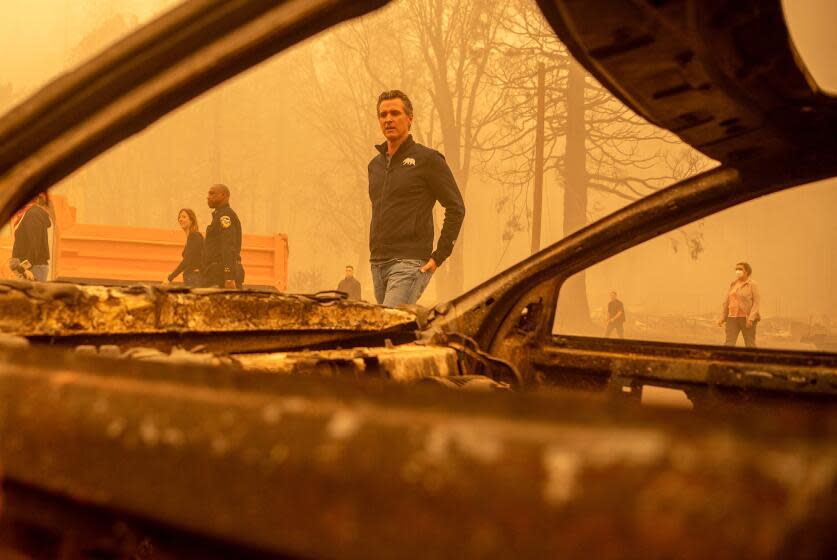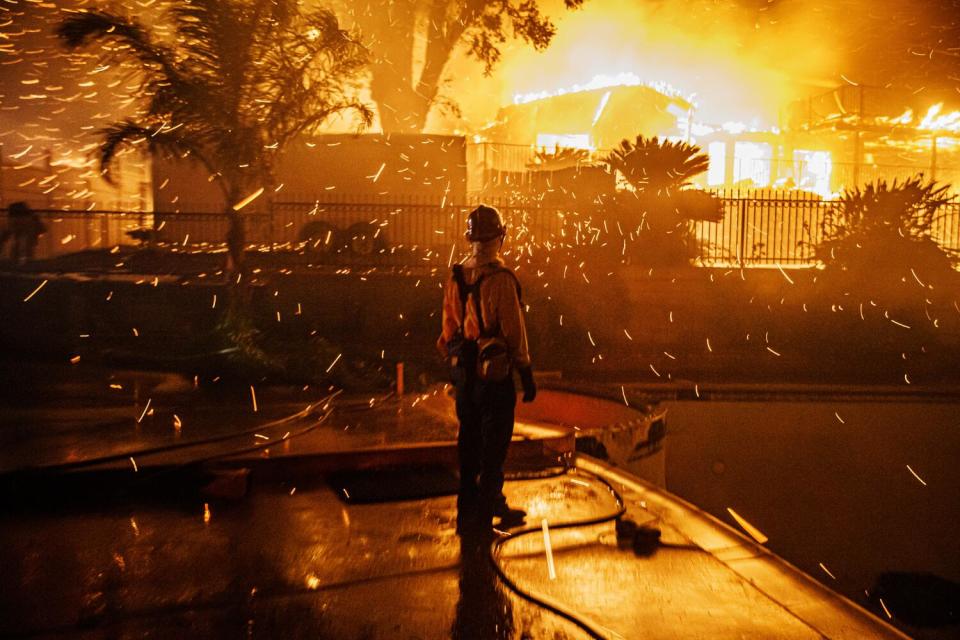Column: Newsom finally gets moving on fixing California's homeowner insurance crisis

Gov. Gavin Newsom has proposed urgency legislation to expedite the hiking of homeowner insurance rates. It’s about time. Because the alternative for many is no insurance at all.
As California property owners are acutely aware, several major insurers have stopped issuing new policies and ceased renewing old ones because, they say, they’re money losers.
Devastating wildfires and other natural disasters resulted in insurers paying out $1.13 in claims for every $1 taken in from premiums during the 10-year period ending in 2022, the industry says.
Insurers contend — and state officials agree — that it takes way too long to increase premium rates to match the volume and size of claims.
State Insurance Commissioner Ricardo Lara has been pecking away at this untenable situation since the fall and hopes to have a new rate-setting system in place by year’s end — too late for the approaching wildfire season.
Read more: Column: Unaffordable homeowner's insurance is leaving Californians exposed to the elements
An impatient Newsom called for swifter action during a May 10 news conference.
“Let’s go. Let’s move this along!” the governor exclaimed.
He promised legislation to require faster review of rate-hike requests.
“It should not take this long for emergency regulations,” the governor asserted. “We can’t wait until December.”
Great. Except then everyone had to wait for the governor to specify what he had in mind. That’s because he almost immediately flew off to the Vatican to attack former President Trump at a climate conference convened by Pope Francis.
Newsom finally delivered last week — without his customary grand pronouncement. No news conference or TV cameras. Just some proposed language for potential legislation tucked onto the state finance department website.
Gubernatorial spokesman Alex Stack issued a statement that read: “This proposal requires the Department of Insurance to modernize and streamline its rate application process to get back to the expedited timelines outlined in Prop 103.”
Proposition 103 is California’s insurance bible. It was a citizens’ initiative approved by voters in 1988 that rolled back rates by 20% for home, auto and many types of insurance. It created an elected insurance commissioner who must approve all rate hikes.

The ballot measure also set a 60-day deadline for approving rates — a time frame that is virtually never met. Rate-setting can drag on for many months, even a year or more.
Newsom proposed returning to the 60-day period theoretically, but also allowing two 30-day extensions for a total of 120 days. That’s still much quicker than the current slow-poke system.
“Upon first blush, it appears to be an improvement,” says Denni Ritter, a Western states lobbyist for the American Property Casualty Insurance Assn.
“The current situation is so bad, companies are unable to operate in California. They need adequate rates in a timely manner. … That’s what it boils down to. Insurers want to sell insurance in California. It’s the fourth largest insurance market in the entire world.”
The governor’s spokesman said, “This is part of our larger package of solutions to ensure Californians have adequate access to insurance.”
“Our” apparently means the governor and the insurance commissioner.
Their total reform package — still being hashed out — potentially includes requiring insurers to cover more high-risk properties, especially homes that have been “hardened” to reduce fire danger.
Insurers would be allowed to project their future liabilities when setting rates, like other states do. And insurers could be reimbursed through premium rates for their cost of insuring themselves against a flood of claims resulting from natural disasters.
Separately, California’s very expensive fire insurer of last resort — FAIR, state-created but privately operated — would be broadened to cover household goods and liability.
All of this makes sense. Sooner the better.
But there’s lots of pushing and shoving going on between a major consumer advocacy group that wrote 103 — Consumer Watchdog — and Lara’s department, which is allied with insurers in this squabble.
Carmen Balber, executive director of Consumer Watchdog, asserted in a statement:
“The governor’s plan invites insurance companies to set their own prices and will kill public participation in rate review. It … turns the Department of Insurance into a rubber-stamp for rate increases. It guts the public intervenor process and will cost insurance consumers billions.”
“Absolutely false,” replies Michael Soller, an insurance department spokesman. “Nothing changes about the intervenor process.”
Read more: California's home insurance crisis: What went wrong, how it can be fixed and what owners can do
What’s this intervenor process? Consumer Watchdog created it in 103. It allows the public to intervene in rate-setting and block homeowner rate hikes exceeding 7%. By far the main intervenor is Consumer Watchdog. It’s at the table in major rate negotiations.
Lara and the insurance industry blame Consumer Watchdog for slowing it all down.
Importantly, the intervenor gets paid with insurance money–ultimately homeowners’ premium money–for participating in rate-setting.
“Consumer Watchdog protects the status quo because it is in their self-interest,” asserted Alan Smith, president of the Western Insurance Agents Assn. “It pockets millions… and it’s shameful.”
Consumer Watchdog last week acknowledged receiving $13.5 million in insurance fees over the last 22 years, but contended it had achieved $6 billion in rate savings. “That amounts to less than 25 cents in fees for every $100 consumers saved,” it said.
But reduced rates don’t mean anything if companies don’t offer them.
Newsom wants his proposal to be approved in a budget “trailer” bill by July 1. But that would be quick and dirty, bypassing the usual scrutiny of legislative policy committees. Some lawmakers aren’t so sure.
“We’ve got to get it right,” says Sen. Susan Rubio (D-Baldwin Park), chair of the Senate Insurance Committee. “We’re in a crisis. Whatever we put in place has to work. Everyone has to be part of the solution. There’s no silver bullet.”
Look for a compromise in late August — mid-fire season.
Meanwhile, Newsom needs to focus hard on this ludicrous dilemma, not just squeeze it in between trips to Rome and national politicking.
This story originally appeared in Los Angeles Times.

 Yahoo Finance
Yahoo Finance 